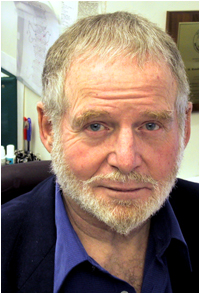 H. Ronald Kaback, MD, Distinguished Professor of Physiology and of Microbiology, Immunology, and Molecular Genetics at the David Geffen School of Medicine at UCLA, will be the leadoff speaker for the 2010 Senior Vice Chancellor’s Laureate Lecture Series, a year-long program highlighting some of the top biomedical researchers in their fields.
H. Ronald Kaback, MD, Distinguished Professor of Physiology and of Microbiology, Immunology, and Molecular Genetics at the David Geffen School of Medicine at UCLA, will be the leadoff speaker for the 2010 Senior Vice Chancellor’s Laureate Lecture Series, a year-long program highlighting some of the top biomedical researchers in their fields.
His lecture, titled “The Old Man and the Membrane,” will focus on membrane transport protein research and will take place at noon on Wednesday, April 21, in Scaife Hall, Auditorium 6.
Kaback is well known for his work characterizing the three-dimensional X-ray crystalline structure of membrane transport proteins. These proteins play a critical role in cellular function, shuttling nutrients, ions, neurotransmitters, and other signaling molecules across the cell membrane. In addition to serving as targets for such widely prescribed drugs as Prozac and Prilosec, membrane transport proteins play a role in a number of human diseases, including cystic fibrosis, diabetes, intestinal malabsorption, and multidrug antibiotic and chemotherapeutic resistance.
Elucidating the molecular basis of the transport process and the mechanism of energy transduction across the biological membrane poses notoriously difficult research challenges for structural biologists, given the complexity and instability of membrane transport proteins. In a 2003 landmark article in Science, Kaback and colleagues reported solving the three-dimensional structure of the bacterial membrane transport protein lactose permease (LacY) using X-ray crystallography. As the most-studied representative of the “major facilitator superfamily” of transport proteins, LacY is a paradigm for ion gradient-driven active translocation in the cell. Through exhaustive structural analyses of experimental data from site-directed LacY mutants, Kaback identified the residues involved in LacY oligosaccharide substrate binding and proton translocation and proposed a working mechanistic model for sugar/proton symport.
Since membrane proteins comprise and are evolutionarily conserved across nearly 30 percent of bacterial and human genomes, Kaback’s research has far-reaching implications for a wide range of studies involving these proteins. He notes that “the most important thing about this [LacY] structure is that we’ve shown it can be done, because people have shied away from attempting to structure these proteins for a long time. I believe that we can expect that 20 years from now every soluble protein that can be crystallized is going to be crystallized.” Further biochemical and computational studies to determine the structure of LacY’s various conformational states will expand our understanding of the transport mechanisms used by LacY and other membrane proteins.
Kaback earned his undergraduate degree in biology from Haverford College and his medical degree from the Albert Einstein College of Medicine, where he also completed a pediatrics internship and one year of graduate study in the Department of Physiology. He then served two years with the U.S. Public Health Service as a commissioned officer before becoming a senior research investigator for the National Heart, Lung, and Blood Institute. In 1972, he moved to the Roche Institute of Molecular Biology in Nutley, New Jersey, where he rose to become head of the Department of Biochemistry. He was recruited to UCLA in 1989 as full professor of physiology and of microbiology, immunology, and molecular genetics and was named a Distinguished Professor in 2004.
Kaback’s many honors include the Lewis S. Rosenstiel Award for Distinguished Work in Basic Medical Science from Brandeis University, the Kenneth S. Cole Award from the Biophysical Society, and the 3M Life Sciences Award of the Federation of American Societies for Experimental Biology, the last shared with Peter Nowell, MD. He is a member of the National Academy of Sciences, the American Academy of Arts and Sciences, and the American Academy of Microbiology.